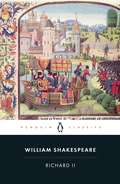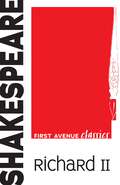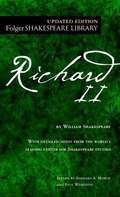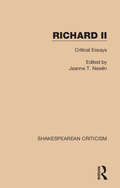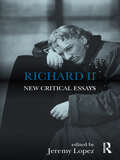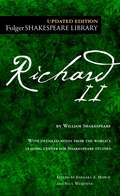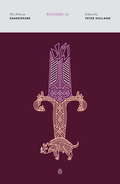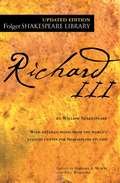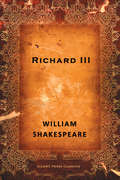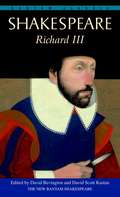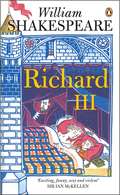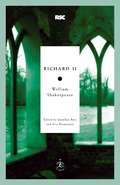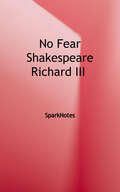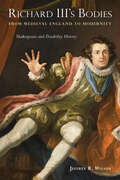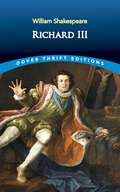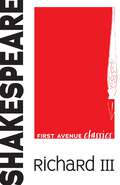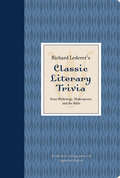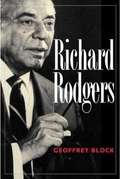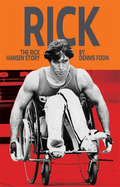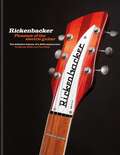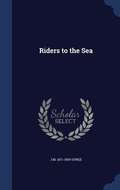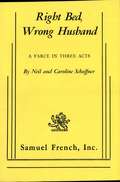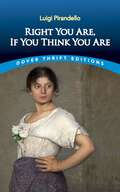- Table View
- List View
Richard II
by William Shakespeare'Not all the water in the rough rude sea Can wash the balm off from an anointed king'Richard, a vain, despotic ruler, listens only to his flatterers. When his cousin Bolingbroke, previously banished, returns to seize the crown, Richard discovers that the throne given to him by God can be taken from him by men. Depicting a tortured and morally ambivalent soul wearing the 'hollow crown', whose illusions are brutally shattered, this tragic history play unravels the idea of kingship. It is also a work of epic lyricism, filled with some of Shakespeare's most intoxicating poetry. Used and Recommended by the National TheatreGeneral Editor Stanley WellsEdited by Stanley Wells Introduction by Paul Edmondson
Richard II (First Avenue Classics ™)
by William ShakespeareThe year is 1398, and the people of England are in a state of unrest. Richard II is not a popular king, as he puts his own interests before the interests of his people. Now he's gone a step too far; he has seized the lands and money of his dead uncle. Richard's cousin, Henry Bolingbroke, was meant to be the heir to this inheritance, and he is incensed that Richard has taken what is rightfully his. When Richard leaves for Ireland to fight a war, Henry takes advantage of his cousin's absence. He assembles an army and awaits Richard's return. A tale of rivalries and shifting power structures, this unabridged edition of the history play by English playwright William Shakespeare was written around 1595 and published in 1597.
Richard II (The Folger Shakespeare Library)
by William Shakespeare Barbara A. Mowat Paul WerstineIn recent years, ways of dealing with Shakespeare's texts and with the interpretation of his plays have been undergoing significant change. This edition, while retaining many of the features that have always made the Folger Shakespeare so attractive to the general reader, at the same time reflects these current ways of thinking about Shakespeare.
Richard II: Critical Essays (Shakespearean Criticism)
by Jeanne T. NewlinOriginally published in 1984. The four parts of this collection of articles, from 1601 to the 1970s, look at the historical and political dynamics of the play, the play in the theatre, the psychology of its characters, and its poetry and rhetoric. Bringing together the best that was written about Richard II, this volume represents the collective wisdom of Shakespeare scholars and provides the most insightful criticism in one place. An unpopular play for many years due to the perceived weak main character and the theme of deposition, the play later gained popularity and interest in its psychology and political investigation. The poetry in particular has garnered enthusiastic response and is mentioned in most of the pieces included here.
Richard II: New Critical Essays (Shakespeare Criticism)
by Jeremy LopezArguably the first play in a Shakespearean tetralogy, Richard II is a unique and compelling political drama whose themes still resonate today. It is one of the few Shakespeare plays written entirely in verse and its format presents unique theatrical challenges. Politically engaged and controversial, it raises crucial debates about the relationship between early modern art, audience response and state power. This collection provides a comprehensive and up-to-date survey of the critical and theatrical history of the play. The substantial introduction surveys the history of critical interpretations of Richard II since the eighteenth century. The eleven newly written critical essays by leading and emerging scholars in the field then adopt an eclectic range of critical approaches that encourage scholars and students to pursue new and imaginative directions with the text.
Richard II: With Notes, Examination Papers, And Plan Of Preparation... (Folger Shakespeare Library)
by William ShakespeareThe authoritative edition of Richard II from The Folger Shakespeare Library, the trusted and widely used Shakespeare series for students and general readers.Shakespeare&’s Richard II presents a momentous struggle between Richard II and his cousin Henry Bolingbroke. Richard is the legitimate king; he succeeded his grandfather, King Edward III, after the earlier death of his father Edward, the Black Prince. Yet Richard is also seen by many as a tyrant. He toys with his subjects, exiling Bolingbroke for six years. When he seizes the title and property that should be Bolingbroke&’s, Richard threatens the very structure of the kingdom. Bolingbroke returns with an army that is supported by nobles and commoners alike, both believing themselves oppressed by Richard. This sets the stage for a confrontation between his army and the tradition of sacred kingship supporting the isolated but now more sympathetic Richard. This edition includes: -Freshly edited text based on the best early printed version of the play -Full explanatory notes conveniently placed on pages facing the text of the play -Scene-by-scene plot summaries -A key to the play&’s famous lines and phrases -An introduction to reading Shakespeare&’s language -An essay by a leading Shakespeare scholar providing a modern perspective on the play -Fresh images from the Folger Shakespeare Library&’s vast holdings of rare books -An annotated guide to further reading Essay by Harry Berger, Jr. The Folger Shakespeare Library in Washington, DC, is home to the world&’s largest collection of Shakespeare&’s printed works, and a magnet for Shakespeare scholars from around the globe. In addition to exhibitions open to the public throughout the year, the Folger offers a full calendar of performances and programs. For more information, visit Folger.edu.
Richard III
by William Shakespeare Stephen Orgel Peter Holland A. R. BraunmullerThe acclaimed Pelican Shakespeare series edition of Richard III edited by A. R. Braunmuller and Stephen Orgel. The legendary Pelican Shakespeare series features authoritative and meticulously researched texts paired with scholarship by renowned Shakespeareans. Each book includes an essay on the theatrical world of Shakespeare’s time, an introduction to the individual play, and a detailed note on the text used. Updated by general editors Stephen Orgel and A. R. Braunmuller, these easy-to-read editions incorporate over thirty years of Shakespeare scholarship undertaken since the original series, edited by Alfred Harbage, appeared between 1956 and 1967. With definitive texts and illuminating essays, the Pelican Shakespeare will remain a valued resource for students, teachers, and theater professionals for many years to come. For more than seventy years, Penguin has been the leading publisher of classic literature in the English-speaking world. With more than 1,700 titles, Penguin Classics represents a global bookshelf of the best works throughout history and across genres and disciplines. Readers trust the series to provide authoritative texts enhanced by introductions and notes by distinguished scholars and contemporary authors, as well as up-to-date translations by award-winning translators.
Richard III
by William ShakespeareRichard III, the hunchback Duke of Gloucester, becomes King Richard III through a series of manipulations and evil schemes. His ambition is the driving force for the plot and he finds little to stand in his way as he strives for domination of all of England.
Richard III
by William ShakespeareEach edition includes: Freshly edited text based on the best early printed version of the play Full explanatory notes conveniently placed on pages facing the text of the play Scene-by-scene plot summaries A key to famous lines and phrases An introduction to reading Shakespeare's language An essay by an outstanding scholar providing a modern perspective on the play Illustrations from the Folger Shakespeare Library's vast holdings of rare books Essay by Phyllis Rackin The Folger Shakespeare Library in Washington, D.C., is home to the world's largest collection of Shakespeare's printed works, and a magnet for Shakespeare scholars from around the globe. In addition to exhibitions open to the public throughout the year, the Folger offers a full calendar of performances and programs. For more information, visit www.folger.edu.
Richard III
by William ShakespeareAn account of the brutal and bloody rise of King Richard III to the throne, Shakespeare's play depicts the short-lived monarch's ruthless campaign for power, which resulted in the deaths of two of his brothers.
Richard III
by William ShakespeareRichard III, the hunchback Duke of Gloucester, becomes King Richard III through a series of manipulations and evil schemes. His ambition is the driving force for the plot and he finds little to stand in his way as he strives for domination of all of England.
Richard III
by William Shakespeare'Now is the winter of our discontent Made glorious summer by this sun of York'Shakespeare's final drama of the Wars of the Roses cycle begins as the dust settles on England after bloody civil war, and the bitter hunchback Richard, brother of the king, secretly plots to seize the throne. Charming and duplicitous, powerfully eloquent and viciously cruel, he is prepared to go to any lengths to achieve his goal. Richard III shows a man who, in his skilful manipulation of events and people, is a chilling incarnation of the temptations of power in a land shocked by war.Used and Recommended by the National TheatreGeneral Editor Stanley WellsEdited by E. A. J. HonigmannIntroduction by Michael Taylor
Richard III (Modern Library Classics)
by William Shakespeare Jonathan Bate Eric RasmussenAn exciting new edition of the complete works of Shakespeare with these features: Illustrated with photographs from New York Shakespeare Festival productions, vivid readable readable introductions for each play by noted scholar David Bevington, a lively personal foreword by Joseph Papp, an insightful essay on the play in performance, modern spelling and pronunciation, up-to-date annotated bibliographies, and convenient listing of key passages.From the Paperback edition.
Richard III (No Fear Shakespeare)
by SparkNotesRead Shakespeare's plays in all their brilliance--and understand what every word means! Don't be intimidated by Shakespeare! These popular guides make the Bard's plays accessible and enjoyable. Each No Fear guide contains: The complete text of the original play A line-by-line translation that puts the words into everyday language. A a complete list of characters, plenty of helpful commentary.
Richard III's Bodies from Medieval England to Modernity: Shakespeare and Disability History
by Jeffrey R. WilsonRichard III will always be central to English disability history as both man and myth—a disabled medieval king made into a monster by his nation’s most important artist. In Richard III’s Bodies from Medieval England to Modernity, Jeffrey Wilson tracks disability over 500 years, from Richard’s own manuscripts, early Tudor propaganda, and x-rays of sixteenth-century paintings through Shakespeare’s soliloquies, into Samuel Johnson’s editorial notes, the first play produced by an African American Theater company, Freudian psychoanalysis, and the rise of disability theater. For Wilson, the changing meanings of disability created through shifting perspectives in Shakespeare’s plays prefigure a series of modern attempts to understand Richard’s body in different disciplinary contexts—from history and philosophy to sociology and medicine. While theorizing a role for Shakespeare in the field of disability history, Wilson reveals how Richard III has become an index for some of modernity’s central concerns—the tension between appearance and reality, the conflict between individual will and external forces of nature and culture, the possibility of upward social mobility, and social interaction between self and other, including questions of discrimination, prejudice, hatred, oppression, power, and justice.
Richard III: Large Print (Dover Thrift Editions: Plays)
by William ShakespeareThe final play in Shakespeare's masterly dramatization of the strife between the Houses of York and Lancaster, Richard III offers a stunning portrait of an archvillain--a man of cunning and ruthless ambition who seduces, betrays and murders his way to the throne. In the process, Richard delivers great speeches and engages in formidable confrontations with a large cast of characters, almost all of them caught up in the terrible struggle for power that dominates the play. It is a tribute to Shakespeare's dramatic genius and knowledge of human psychology that by the end of the drama the detestable Richard begins to elicit some sympathy for the awful plight in which he finds himself. Explanatory footnotes and an introductory note are included.
Richard III: Large Print (First Avenue Classics ™)
by William ShakespeareTrouble is brewing for King Edward IV. Edward's youngest brother, Richard, is jealous of Edward's power and influence. Richard will do anything to overthrow the king: He manipulates a noblewoman into marrying him. He arranges for his brother Clarence to be executed, then blames Clarence's death on King Edward. After Edward becomes ill and dies, Richard attains the throne through villainous means. But Richard's trail of deception, manipulation, and murder might eventually be the cause of his own downfall. This unabridged edition of the history play written by English playwright William Shakespeare was written around 1592 and first published in 1597.
Richard Lederer's Classic Literary Trivia: From Mythology, Shakespeare, and the Bible
by Richard LedererIn this follow-up to Richard Lederer&’s Literary Trivia, the author delves into curious facts and anecdotes about mythology, Shakespeare, and the Bible. Through his numerous books and syndicated columns, Richard Lederer&’s infectious love of language and literature has inspired and intrigued readers for decades. Now the author of Lederer on Language and Anguished English delivers a volume full of fascinating trivia about some of Western literature&’s most foundational works. Here you will be able to test—and expand—your knowledge of the Bible, ancient Greek mythology, and the plays and poetry of William Shakespeare.
Richard Rodgers
by Geoffrey BlockGeoffrey Block examines the entire range of Rodgers's work, providing rich details about the creation, staging, and critical reception of some of his most popular musicals.
Rick: The Rick Hansen Story
by Dennis FoonFifteen-year-old Rick Hansen is confident, outgoing, and the star of his high-school basketball team. He has his whole life planned out, until a tragic accident severs his spinal cord, leaving him in a wheelchair. Rick's accident forces him to adapt his positivity to deal with his new life, while helping to strengthen the relationship with his guilt-stricken best friend. Refusing to be put at a disadvantage, Rick conquers the challenges presented to him with a smile and changes the definition of what it means to be disabled. Based on the true story of the man who inspired millions with his Man In Motion World Tour, Rick is a triumphant play that showcases the importance of optimism and perseverance, encouraging audiences to make their own paths to change the world.
Rickenbacker Guitars: The definitive history of a 20th-century icon
by Martin Kelly Paul KellyA STUNNING NEW AND COMPLETELY REVISED EDITION OF THE RICKENBACKER BIBLE FOR 2023'Knowing Martin and Paul Kelly's perfectionism and attention to detail it's no surprise that this is the ultimate and complete story of all things Rickenbacker.' - Johnny Marr'A wonderful history of my favourite guitar. The attention to detail is amazing!' - Roger McGuinn'There are few things more satisfying than the shimmer of an open chord played on a Rickenbacker through a Fender Deluxe Reverb amplifier. Martin and Paul have given us the definitive history of these magical instruments.' - Susanna HoffsRickenbacker Guitars is the highly anticipated follow up to Fender: The Golden Age, charting the story of one of the most important and influential guitar makers of all time. From George Beauchamp's invention of the world's first commercially viable electric guitar in 1931, through the company's heyday during the 1960s - when their instruments were favoured by The Beatles, The Byrds and The Who - and up to the continuing legacy of Rickenbacker today.This definitive collection features unprecedented access to the company archives, 350 beautifully photographed original instruments - including all 7 surviving Beatles owned Rickenbackers - and new interviews with legendary Rickenbacker players such as Roger McGuinn, Peter Buck, Susanna Hoffs, Johnny Marr, Mike Campbell, Geddy Lee and Paul Weller.Rickenbacker Guitars is the most comprehensive history of the brand to date and a must-have for all guitar enthusiasts.
Rickenbacker Guitars: The definitive history of a 20th-century icon
by Martin Kelly Paul KellyA STUNNING NEW AND COMPLETELY REVISED EDITION OF THE RICKENBACKER BIBLE FOR 2023'Knowing Martin and Paul Kelly's perfectionism and attention to detail it's no surprise that this is the ultimate and complete story of all things Rickenbacker.' - Johnny Marr'A wonderful history of my favourite guitar. The attention to detail is amazing!' - Roger McGuinn'There are few things more satisfying than the shimmer of an open chord played on a Rickenbacker through a Fender Deluxe Reverb amplifier. Martin and Paul have given us the definitive history of these magical instruments.' - Susanna HoffsRickenbacker Guitars is the highly anticipated follow up to Fender: The Golden Age, charting the story of one of the most important and influential guitar makers of all time. From George Beauchamp's invention of the world's first commercially viable electric guitar in 1931, through the company's heyday during the 1960s - when their instruments were favoured by The Beatles, The Byrds and The Who - and up to the continuing legacy of Rickenbacker today.This definitive collection features unprecedented access to the company archives, 350 beautifully photographed original instruments - including all 7 surviving Beatles owned Rickenbackers - and new interviews with legendary Rickenbacker players such as Roger McGuinn, Peter Buck, Susanna Hoffs, Johnny Marr, Mike Campbell, Geddy Lee and Paul Weller.Rickenbacker Guitars is the most comprehensive history of the brand to date and a must-have for all guitar enthusiasts.
Riders to the Sea
by J. M. SyngeThis work has been selected by scholars as being culturally important, and is part of the knowledge base of civilization as we know it. This work was reproduced from the original artifact, and remains as true to the original work as possible. Therefore, you will see the original copyright references, library stamps (as most of these works have been housed in our most important libraries around the world), and other notations in the work. This work is in the public domain in the United States of America, and possibly other nations. Within the United States, you may freely copy and distribute this work, as no entity (individual or corporate) has a copyright on the body of the work. As a reproduction of a historical artifact, this work may contain missing or blurred pages, poor pictures, errant marks, etc. Scholars believe, and we concur, that this work is important enough to be preserved, reproduced, and made generally available to the public. We appreciate your support of the preservation process, and thank you for being an important part of keeping this knowledge alive and relevant.
Right Bed Wrong Husband
by Neil SchaffnerFarce / 4m, 3f / Interior / In order to have his allowance increased, young bachelor Ted has written his pinchpenny uncle that he is married, though in fact he is only engaged. Suddenly one day uncle drops in unexpectedly, and very much against his will Ted is drawn into the vortex of an intrigue initiated entirely by the uncle when he mistakes a pretty girl, married to Ted's best friend, as Ted's wife. Ted is basically honest and does not want to deceive his uncle, but every time uncle kisses the "wife" he ups the ante to say nothing of kindling the ire of Ted's friend; and Ted is not sap enough to turn that down. Complications come tumbling after when the maid calls and is mistaken for something else; when the real fiancee returns and is caught kissing Ted; but especially at night then the time comes to retire. Add the neighborhood drunk who habitually sacks in with Ted when he's locked out of his own house, and you have a climax of enormous merriment.
Right You Are, If You Think You Are: Six Characters In Search Of An Author Henry Iv. Right You Are! (if You Think So) (classic Reprint) (Dover Thrift Editions: Plays)
by Luigi PirandelloWinner of the Nobel Prize for Literature in 1934, Italian playwright Luigi Pirandello (1867-1936) explored such themes as the relativity of truth, the vanity and necessity of illusion, and the instability of human personality. In this famous play, an expressionistic parable set in a small Italian town in the early twentieth century, Pirandello skillfully dramatizes these issues.The observer Laudisi derides the townspeople for their insistence on knowing the secrets of Mrs. Frola and her married daughter: Why does Mrs. Frola live alone and not with her daughter? Why do the two never visit each other? The answers to these questions lie at the heart of this play and at the center of Pirandello's artistic vision. Presented in an excellent new English translation, this inexpensive edition will delight students and lovers of modern drama.
